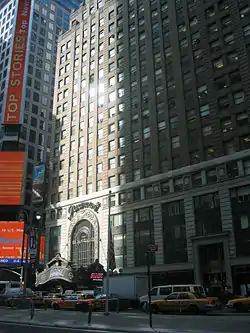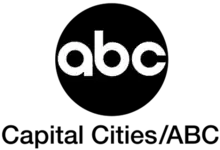American Broadcasting-Paramount Theatres
American Broadcasting-Paramount Theatres, Inc. (originally United Paramount Theatres, later the American Broadcasting Companies and ABC Television) was the post-merger parent company of the American Broadcasting Company and United Paramount Theatres.
 American Broadcasting-Paramount Theatres former headquarters located in 1501 Broadway. | |
| Formerly |
|
|---|---|
| Type | Public |
| Industry | Movie theater, radio broadcasting, television broadcasting, publishing, recording |
| Predecessor |
|
| Founded | November 15, 1949 |
| Founder | Paramount Pictures |
| Defunct | July 24, 1989 |
| Fate | Purchased and dissolved |
| Successors | Capital Cities/ABC (1985–1996) |
| Headquarters | 1501 Broadway, , |
Area served | Nationwide |
| Revenue | |
| Total assets | |
| Total equity | |
| Owner | Edward J. Noble (10% common, 55% preferred)[1] |
| Divisions |
|
| Subsidiaries |
|
| Footnotes / references [2] | |
History
United Paramount Theatres
United Paramount Theatres, Inc. (UPT) was incorporated on November 15, 1949,[3] as a spin off of Paramount Pictures' movie theater operations pursuant to the Supreme Court anti-trust ruling in United States v. Paramount Pictures, Inc..[4] UPT took over Paramount's theater chains,[5] which included Balaban and Katz, a Chicago-based circuit that also included some broadcasting interests. 800 of the 1,450 Paramount theaters were to be divested. A court appointed trustee would control UPT stock for five years to ensure separate ownership of the two businesses. Paramount stockholders were to receive stock in both companies, with a conversion provision that would allow a shareholder to exchange its stock in one successor into the other company's stock.[6] Leonard Goldenson, who had headed the theater chain since 1938, remained as UPT's president. With the American Broadcasting Company (ABC) looking to enter television, UPT had the cash from the divested theaters and was looking to invest that money elsewhere, as it was barred from film making. ABC also considered International Telephone & Telegraph and General Tire, before accepting UPT's offer.[7]
In 1950, UPT acquired a 1/3 share of Microwave Associates, Inc., a consulting and research company for millimeter-wave technology.[2][8]
American Broadcasting-Paramount Theatres
American Broadcasting-Paramount Theatres, Inc. (AB-PT) became the name of United Paramount Theatres, Inc. on February 9, 1953,[3] to reflect its post merger status as the parent company of the merged companies, American Broadcasting Company and United Paramount Theatres.[9] The Federal Communications Commission approved the merger that same day. Leonard H. Goldenson continued as corporate president post merger with ABC president Robert E. Kintner continuing as ABC division president. No general theater division similar to the ABC division was set up as AB-PT corporate would handle overall theater planning and development. ABC division was slated to move out of the RCA Building to 7 W. 66th Street, New York City by April 1. The sale of WBKB (TV) in Chicago to CBS for $6 million was also approved by the FCC.[1]
In 1954, AB-PT made a deal with Walt Disney to provide capital for his proposed Disneyland project in Anaheim, California. For $500,000 in cash and a guarantee of $4.5 million in bank loans, AB-PT acquired a 34.48% interest in Disneyland, Inc. and secured an agreement with Walt Disney Productions to provide programs for the ABC-TV network.[10] AB-PT's subsidiary, UPT Concessions, Inc. was enlisted to operate Tomorrowland's Space Bar (original name Stratosnak) and other concession establishments within Disneyland.[11][12]
ABC-Paramount formed a records division in 1955, with Samuel H. Clark as its first president.[13] The business was incorporated on June 14, 1955, as Am-Par Record Corporation.[14]
| Theater circuit (in 1955) | state(s)[2] |
|---|---|
| Arizona Paramount | Arizona |
| Balaban and Katz | Illinois |
| Florida State | Florida |
| Great States | Illinois, Indiana, Ohio |
| Minnesota Amusement | Minnesota, Wisconsin, North & South Dakotas |
| New England | Massachusetts, Maine, Vermont, New Hampshire, Connecticut, Rhode Island |
| Northio | Ohio, Kentucky |
| Paramount Gulf | Louisiana, Mississippi, Alabama, Florida, Texas |
| Penn Paramount | Pennsylvania |
| Tenarken Paramount | Arkansas, Tennessee, Kentucky |
| Texas Consolidated | Texas |
| Tri-States | Iowa, Nebraska, Illinois, Missouri |
| United Detroit | Michigan |
| Wilby-Kincey | Alabama, Georgia, North & South Carolina, Tennessee, Virginia, West Virginia |
In February 1956, along with Western Union, AB-PT agreed to purchase a 22% share of Technical Operations, Inc. a nucleonics, operations research, chemistry and electronics company, with options to increase the share to 25%. In a related transaction, Western Union acquired a 1/3 share in Microwave Associates, allowing that AB-PT holding to purchase a site for a new plant.[2] On December 30, 1956, a film production company, American Broadcasting-Paramount Theatres Pictures was formed, with Irving H. Levin as President.[15]
By March 1957, AB-PT's theater circuits had divested more theaters than required by the court ruling. In June, AB-PT decided to sell 90 more theaters due to declining revenue.[9]
In 1957, Microwave Associates became a publicly traded corporation.[8] On May 1, 1957, the American Broadcasting Company Radio Network was formed as an autonomous subsidiary, with Robert E. Eastman as President.[16]

AB-PT purchased the Weeki Wachee Springs natural tourist attraction in Florida in 1959.[17] Also in 1959, AB-PT acquired the Prairie Farmer agricultural publishing group, including Chicago radio station WLS (AM), which shared a frequency with AB-PT's station WENR (defunct).[18] In 1960, Walt Disney Productions paid $7.5 million to buy back AB-PT's share in Disneyland and obtain a release from its ABC-TV contract.[19] In 1962, AB-PT purchased another Florida nature attraction, Silver Springs, and placed it into the company's ABC Scenic & Wildlife Attractions subsidiary.[20]
American Broadcasting Companies
American Broadcasting-Paramount Theatres, Inc. assumed the name, American Broadcasting Companies, Inc. on July 2, 1965.[3] ABC started ABC Pictures in 1965 to produce feature films.[21] In 1965, Clark was appointed vice-president, non-broadcasting operation of American Broadcasting Companies overseeing ABC-Paramount Records, ABC music publishing, theater operations, ABC Pictures, ABC Amusements and other operations. In April 1966, Dunhill Records was purchased.[22] American Broadcasting Companies move from the New York City Paramount Building to the ABC Building at 1330 Avenue of the Americas, in 1965.[23] Its recording subsidiary was renamed ABC Records in 1966.[24]
On December 7, 1965, Goldenson announced a merger proposal with ITT to ABCs board. The two companies agreed to the deal on April 27, 1966.[25] The FCC approved the merger on December 21, 1966; however the previous day (December 20), Donald F. Turner, head antitrust regulator for the United States Department of Justice, expressed doubts related to such issues as the emerging cable television market,[26] and concerns over the journalistic integrity of ABC and how it could be influenced by the overseas ownership of ITT.[27] ITT management promised that the company would allow ABC to retain autonomy in the publishing business.[26] The merger was suspended, and a complaint was filed by the Department of Justice in July 1967, with ITT going to trial in October 1967; the merger was officially canceled after the trial's conclusion on January 1, 1968.[28]
By May 1972, ABCs formed the ABC Leisure Group consisting of its theaters, farm publishing operations (ABC Farm Publications) and music (ABC Records), Anchor Records and ABC Records and Tape Sales plus a new retail record store division.[29] In January 1973, ABC Leisure Group started ABC Retail Records Division was started head by president Al Franklin. Three Wide World of Music locations in Seattle and Providence were opened by July 1974, when they announced expansion to add 4 more locations.[30] In 1974 by August, ABC Records had acquired two additional record companies.[31] Leisure Group I added ABC Leisure Magazines and ABC Entertainment Center, Center City by October 1974.[32]
Plitt Theatres purchased ABC Theatres northern group of movie theaters including the Balaban & Katz chain in 1974. A second Plitt corporation, Plitt Theatres Holding, purchased ABC's southern circuit in 1978 for $49 million.[33]
ABC Scenic & Wildlife Attractions president John Campbell announced on April 27, 1973, its plans for developing its third wildlife preserve on 280 acres in Prince George's County, Maryland, 12 miles from Washington, DC.[34] On July 15, 1974, The Wildlife Preserve opened in Prince George's County.[35] In October 1974, ABC Leisure Group II was formed by ABC, composed of ABC Theatres (267 locations), ABC Scenic & Wildlife Attractions, Town of Smithville, NJ recreated historic settlement and the Silver Springs Bottled Water Co., under president Walter Schwartz.[32]
ABC Motion Pictures was a theatrical movie subsidiary of ABC, formed in May 1979.[36]
A cable division was started in July 1979[37] which was incorporated as ABC Video Enterprises, Inc. (AVE) by March 25, 1980.[38] The company also doubled as a home video division of ABC. ABC announced ARTS in December 1980 to be launched on April 5, 1981, sharing Nickelodeon's channel at night. ABC and the Hearst Corporation in January 1981 formed a joint venture, Hearst/ABC Video Services, to provide programming to ARTS and launch BETA, a women's network, later that year.[37] With Group W Satellite Communications, ABC Video Enterprises formed the Satellite News Channel in 1981 only to sell it a year later to Turner Broadcasting, owner of CNN. Cox Cable and AVE formed FirstTicket in 1983, to try the market for pay-per-view sporting events. AVE and ESPN launched Reserve Seat Video Productions, a pay-per-view sports producer, in 1983.[39]
In 1984, ABC Scenic & Wildlife Attractions sold both Florida locations to Florida Leisure Attractions.[40] In 1984, Hearst/ABC-Viacom Entertainment Services (HAVES) was formed from the merger of Daytime (BETA) and Lifetime Medical Television to start and operate a new cable channel, Lifetime Television.[41]

Capital Cities' announced $3.5 billion purchase of ABC on March 18, 1985, stunned the media industry, as ABC was some four times bigger than Capital Cities was at the time. Berkshire Hathaway chairman Warren Buffett helped to finance the deal in exchange for a 25 percent share in the combined company.[42][43]
In October 1985, ABC Motion Pictures was shut down.[44]
References
- "Ambitious ABC Planning Initiated Under New Merged Ownership" (PDF). BROADCASTING TELECASTING. Vol. 44, no. 7. February 16, 1953. pp. 27–29. Retrieved April 8, 2015.
- "Annual Report 1955" (PDF). University of Penn. American Broadcasting-Paramount Theatres, Inc. Archived from the original (PDF) on March 4, 2016. Retrieved April 8, 2015.
- "Entity Information: American Broadcasting Companies, Inc". Corporation & Business Entity Database. New York State Division of Corporations. Retrieved April 6, 2015.
- Legrand 1992, p. 422.
- Slide, Anthony (February 25, 2014). "Publix Theater Corp.". The New Historical Dictionary of the American Film Industry (revised and updated ed.). Routledge. ISBN 9781135925611. Retrieved April 7, 2015.
- "Paramount; radio, video interests definitely split" (PDF). Broadcasting - Telecasting. March 7, 1949. p. 66. Retrieved April 7, 2015.
WBKB (TV) Chicago, licensed to the Paramount subsidiary Balaban & Katz, will go to a firm to be known as New Theatre Co." New Theatre Co. would later be formally named as United Paramount Theatres
- Roman, James W. (2005). From Daytime to Primetime: The History of American Television Programs. Greenwood Publishing Group. pp. 12–13. ISBN 0313319723. Retrieved April 7, 2015.
- Hindle, Pat (April 1, 2010). "M/A-COM is Reborn on Its 60th Birthday". Microwave Journal. Archived from the original on March 7, 2015.
- Conant, Michael (1960). Antitrust in the Motion Picture Industry. University of California Press. p. 112. Retrieved April 7, 2015.
American Broadcasting-Paramount Theatres.
- Thomas, Bob (1998). Building a Company - Roy O. Disney and the Creation of an Entertainment Empire. pp. 183, 185. Retrieved April 7, 2015.
- "Disneyland Space Bar..." Independent Press Telegram. No. Souvenir Edition. July 15, 1955. p. 4. Retrieved August 28, 2015.
- "The Story of Disneyland" (PDF). disneybymark.com. Disneyland, Inc. p. 16. Archived from the original (PDF) on March 5, 2016. Retrieved August 28, 2015.
- "ABC: Brief History". Billboard. 1970-09-12. Retrieved 2011-09-10 – via Google Books.
- "Entity Information: ABC Records, INC". Corporation & Business Entity Database. New York State Division of Corporations. Retrieved April 6, 2015.
- Kane, Sherwin, ed. (May 10, 1957). "ABPT Pictures Set 3 Goals". Motion Picture Daily. Vol. 81, no. 91. Martin Quigley. pp. 1–2 – via Internet Archive.
- Kane, Sherwin, ed. (April 12, 1957). "ABC Radio Separate Subsidiary of AB-PT". Motion Picture Daily. Vol. 81, no. 71. Martin Quigley. p. 6 – via Internet Archive.
- JAKOB SCHILLER. "Professional Mermaids Are Lost Treasure of Florida Park". Wired. Condé Nast. Retrieved 24 November 2013.
- Lazarus, George (July 1, 1997). "Australian Firm Buys Parent Of Prairie Farmer Magazine From Disney". Chicago Tribune. Retrieved August 9, 2015.
- Thomas, Bob (1994). Walt Disney: An American Original. p. 286. Retrieved April 7, 2015.
- Colesworthy, Bick (May 25, 1977). "Silver Springs Has Magic of Nature". Daytona Beach Morning Journal. Plam Coast News. p. 5. Retrieved April 10, 2015.
- Schreger, Charles (May 27, 1979). "ABC looks to big screen". The Spokesman-Review. Vol. 93, no. 13. Spokane, Washington. Los Angeles Times. p. F7. Retrieved April 7, 2015.
- "ABC: Brief History". Billboard. September 12, 1970. pp. abc2–abc3. Retrieved 2011-09-10 – via Google Books.
- "ABC-Paramount Through the Years" (PDF). Billboard. Vol. 77, no. 38. September 18, 1965. p. 48. Retrieved November 15, 2018.
- "ABC-Paramount Is Now abc Records" (PDF). The Billboard. June 18, 1966. p. 3. Retrieved April 15, 2015.
- Goldenson & Wolf 1991–1993, p. 260.
- Goldenson & Wolf 1991–1993, p. 262.
- Goldenson & Wolf 1991–1993, p. 261.
- Goldenson & Wolf 1991–1993, p. 263.
- "ABC Records 73 Sales, Earnings Up from 1972". Billboard. Vol. 86, no. 19. Nielsen Business Media, Inc. May 11, 1974. pp. 8, 80. Retrieved April 1, 2015.
- "ABC Disk Chain Adding 4 Shops". Billboard. Vol. 86, no. 27. July 6, 1974. Retrieved April 10, 2015.
- "ABC Determined to Lead, Prexy Avers". Billboard. Vol. 86, no. 32. August 10, 1974. Retrieved April 10, 2015.
- "ABC Rings Up Impressive Income of $11.4 Million". Billboard. No. 8. November 2, 1974.
- Storch, Charles (August 16, 1985). "Plitt Theaters Sold For $65 Million". Chicago Tribune. Retrieved April 13, 2015.
- "Wildlife Park Plans Announced by ABC". Ocala Star-Banner. April 27, 1973. p. 6A. Retrieved April 6, 2015.
- "The Wildlife Preserve opens in the East". The Southeast Missourian. July 12, 1974. p. 20. Retrieved April 6, 2015.
- Harmetz, Aljean (November 21, 1985). "It's Curtains For Abc, Cbs Filmmaking". Chicago Tribune. New York Times News Service. Retrieved January 2, 2014.
- "ABC and Hearst Set Up Women's Cable TV; ABC and Hearst Set Up Cable TV Unit for Women". New York Times. January 30, 1981. Retrieved April 13, 2015.
- "Entity Information: ABC Video Enterprises, Inc". Corporation & Business Entity Database. New York State Division of Corporations. Retrieved April 13, 2015.
- Harrigan, Kathryn Rudie (January 1, 1985). Joint Ventures, Alliances, and Corporate Strategy (reprint ed.). Beard Books. pp. 169–170. ISBN 1587981955. Retrieved April 13, 2015.
- Hollis, Tim (2005). Glass Bottom Boats & Mermaid Tails: Florida's Tourist Springs. Stackpole Books. p. 116. ISBN 9780811732666. Retrieved April 10, 2015.
- Lifetime Entertainment Services History. International Directory of Company Histories, Vol. 32. St. James Press, 2000. Hosted on Funding Universe.com. Retrieved on December 4, 2013.
- Kleinfield, N.R. "ABC is being sold for $3.5 billion; 1st network sale." The New York Times, March 19, 1985.
- "Capcities + ABC." Broadcasting, March 25, 1985, pp. 31-32.
- Fabrikant, Geraldine (October 29, 1985). "ABC Discontinues Movie Operations". New York Times. Retrieved January 2, 2014.
- "Entity Information: American Broadcasting Companies, Inc". 6. New York State Division of Corporations. Retrieved April 6, 2015.
Bibliography
- Goldenson, Leonard H.; Wolf, Marvin J. (1991–1993). Beating the Odds: The Untold Story Behind the Rise of ABC. New York City: Charles Scribner's Sons. ISBN 0-684-19055-9.
- Legrand, Jacques (1992). Lherminier, Pierre (ed.). Chronique du cinéma [Chronicles of the Cinema] (in French). Éditions Chronique. ISBN 9782905969552.
- Polsson, Ken. Chronology of Disneyland Theme Park.